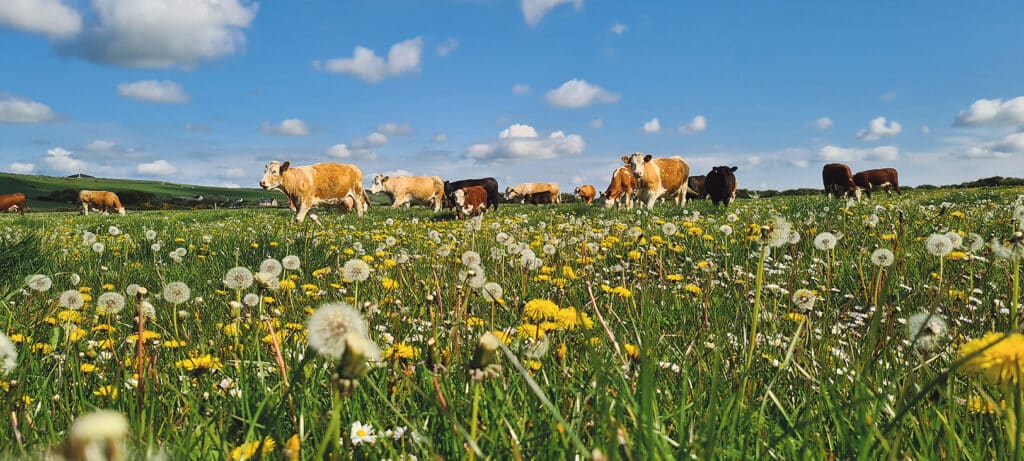With over 5,000 participants in the Organic Farming Scheme in 2024, the area being farmed organically in Ireland has tripled since 2020. While this shows a significant pace of growth, it is however still far off the EU target of 25 per cent of agricultural land in the EU to be used for organic farming by 2030. With a background in agriculture and organic food production, Fruit Hill Farm owner Elmer Koomans is well placed to assist West Cork farmers interested in learning more about making the move to organic.

For any farmer considering converting to organic, geographical location, soil type, and soil fertility must all be taken into consideration when deciding on crops and fertilisers.
For a dairy farmer, the ease of making the move into organic production will depend on the stocking rate of the farm and the quality of the soil. According to Elmer, with no collection of organic milk in West Cork, some dairy farmers, instead of going certified, farm as close to organic principles as possible. “The farmers I have spoken to reckon that the animals perform better, are healthier and the margin at the end is better,” he shares.
Whether it is organic principles or the bottom line that a farmer is more interested in, with the rising costs of chemical fertilisers, the the hardier variety-rich clover-grass mixes needing less input, provide an attractive alternative.
“Instead of a monoculture of perennial ryegrass and a smidgen of white clover, it is better to grow a mix with a much wider variety of grasses, more white clover, possibly some red clover and some grassland herbs like chicory, plantain, yarrow and so on,” explains Elmer. “These mixtures with a wider variety last much longer and are not so dependent on fertiliser inputs, although it is still important to maintain a good pH and reasonable levels of phosphorus and potash.”
Due to the more diverse and intensive root system, these variety rich pastures are also much more resilient during prolonged spells of very dry or wet weather.
“An existing pasture can be improved by overseeding or stitching in,” explains Elmer. “One doesn’t always have to plough, which is not always possible anyway for various reasons.”
Environmentally-friendly and non-toxic in nature and to humans, organic fertilisers will improve soil health rather than degrade it. Fruit Hill Farm carries a mixture of plant origin, animal origin and mineral origin fertilisers, all approved for use in organic growing. “Most are for horticulture or tillage, but for example PatentKali (25 per cent K, 17 per cent S, 6 per cent Mg) and Kalisop (42 per cent K, 17 per cent S) are two great fertilisers for grassland,” shares Elmer. “It can be hard to keep up the level of potash and sulphur during the season on lands that are naturally low in potash already, especially when heavy cuts of white or red clover silage are being produced. These fertilisers are very effective and a good response will be noticed. On land low in phosphorus, granulated rock phosphate 11 per cent phosphorous can be applied. We also have granulated lime now which is approved for use in organic.
“For tillage crops, grassland or when reseeding, an application of 250kg/acre of chicken manure pellets can really make a difference to the crop. We have this now in 600kg bags at a very cost-effective price.”
Taking the location and the soil into account, crops that typically grow well in the Irish climate using organic principles are oats, triticale, rye (hybrid) and in better soils barley and wheat.
“Combicrops, which means a combination of cereals and a bean or pea variety, are very popular as a combining crop in organic farming,” says Elmer. “These combicrops are less prone to diseases, and also the weeds get suppressed better than in monocultures of either. When these crops are grown for a silage cut before they are fully ripe; they are called wholecrops.”
With a large selection of blight resistant seed potatoes now available, while proper management of the crop is still essential, it has become much easier for farmers to grow a good yielding crop without the use of fungicides. The more blight-resistant genes in a variety the better, which are bred by crossing existing varieties.
“The advantage of these varieties,” shares Elmer “is that there is a lot less risk of losing a crop, and much more security of a good yield. The disadvantage is that a lot of these varieties are quite new and consumers are used to certain varieties that they like and can be slow to change over to new varieties. We have some really good varieties though and customers are very happy with varieties like Connect, Alouette, Vitabella, Sarpo Mira and Axona.
“Blight resistance is only one of the criteria of selection, the potato also needs to have resistance to other diseases, like viruses spread by aphids, it also has to yield well, look good, harvest well, cook well and taste good.”
When any crop is harvested nutrients are removed from the soil, so replacing these nutrients and preventing soil degradation is essential to maintaining quality of yields. Diverse crop rotation or cover crops can hold nutrients and maintain and improve the overall structure of the soil.
“Leguminous cover crops are able to fix nitrogen with the help of the nitrogen fixing bacteria living on their roots,” shares Elmer. Some cover crops are short term and only grown during the winter period, while others can be left in for two years.
One of the biggest challenges for organic growers is weed control, as without the ease of herbicides, weeds can compete with new seedlings. For a successful crop, it is essential to put preventive measures in place for controlling weed seeds, which can stay dormant in the soil for a long time. “in organic farming weed control has to be mechanical or thermal,” says Elmer “so it has to be done with hoes or hoeing machines depending on the scale.
“In horticulture, flame weeders are used at the early stages of a crop when weeds are only just germinating. Ploughing can be a very effective way of burying weeds, also the creation of a stale seedbed is important, which means let the weeds germinate first, then lightly cultivate to kill them and then sow or plant the crop into a clean seedbed.”
While applications for the Organic Farming Scheme (OFS) have now closed, if a farmer is serious about converting to organic, then putting the research in now will pay dividends. “Every time the organic farming scheme opens up, there are very good subsidies available, making it a lot less painful to convert,” says Elmer. While even with the subsidies the cost of switching to organic can be high, there are many advantages to embracing this more sustainable alternative to conventional farming. “There can be a better margin due to lower inputs; healthier soil, plants and animals; less pollution and erosion of the environment and a more resilient farming system, which may be very important with the climate change that is happening,” says Elmer.
Whether you’re committed or still on the fence about the switch to organic, Elmer advises a slow and steady approach for optimum results. “Don’t rush into it, do the research first, do some trials first and see how they go. Go to as many organic farm walks as possible and talk to farmers and growers that have converted and learn from their experience. It has to fit the farm and the farmer –– it will be easier to convert for a less intensive farm. A lot of the principles can be applied without ever going fully certified.”


